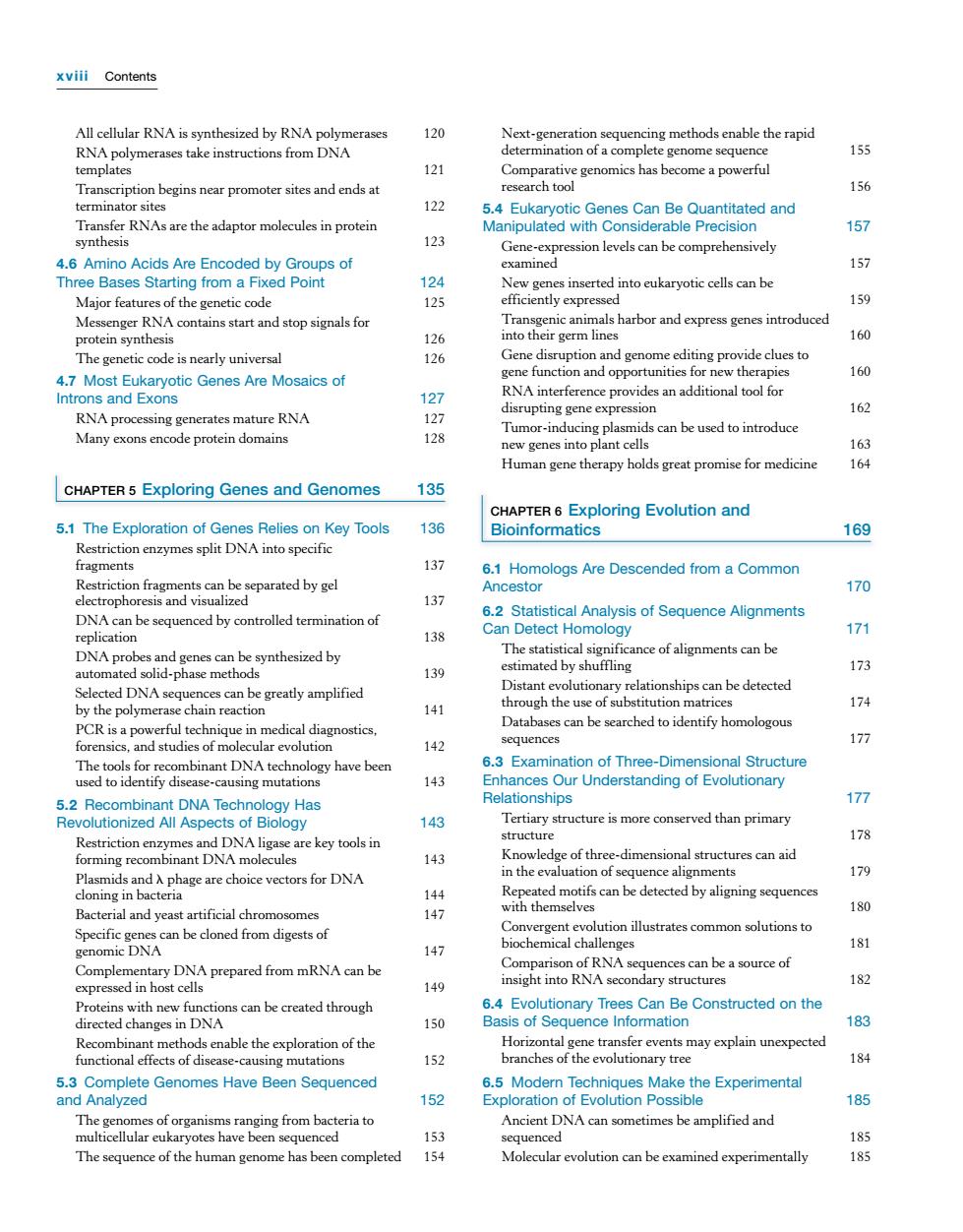正在加载图片...

xviii Contents 120 templates 白 你 Comparative genmics has become a powerful Tran cription begins near promoter sites and ends at search toc 156 122 are the adaptor 白 157 4.6 Amino Acids Are Encoded by Groups of examined 157 Three Bases Starting from a Fixed Point 2 Major featu intoeukaryotic cellscan be s of the genetic code 125 159 enger RNA contains start and stop signals for 126 160 The genetic code is nearly universal 126 Gene diruption and provide clues to 160 127 disrupting gene expression 162 RNA processing generates mature RNA Many exons encode protein domains 128 Iumor-inducing plas s can be used to introduce 164 CHAPTER 5 Exploring Genes and Genomes 136 5.1 The Exploration of Genes Relies on Key Tools 13 xploring Evolution and Bioinformatics 169 plit dna inte ecific fragments 6.1 Homoloas Are Descended from a Common separated by gel Ancestor 170 DNA can be sequenced by controlled termination of 6.2 Statistical Analysis of Sequence Alignments 138 Can Detect Homology Testatiticalsini cance of alignments can be 139 173 Selected DNA sequences can be greatly amplified Dista nbe detected 174 e polymer Databases can be searched to identify homologous 177 6.3 Exami of Three-Dime 143 今 d DNA 143 Tertiary structure is more conser ved than primary 178 forming recombinant DNA molecules ekey toos in ructur 143 res can aid phage are DNA 179 Bacterial and yeast artificial chro cabe detected 180 tion illustrates solutions to 西 149 182 ions can be created through 150 8a5atomamceocanmBeconstnuctedonthe 183 ted 184 5.3 Complete Genomes Have Been Sequenced and Analyzed 185 anging from bacteria to Ancient DNA can sometimes be amplified and 153 completed 154 evolution can be examined experimentally xviii Contents All cellular RNA is synthesized by RNA polymerases 120 RNA polymerases take instructions from DNA templates 121 Transcription begins near promoter sites and ends at terminator sites 122 Transfer RNAs are the adaptor molecules in protein synthesis 123 4.6 Amino Acids Are Encoded by Groups of Three Bases Starting from a Fixed Point 124 Major features of the genetic code 125 Messenger RNA contains start and stop signals for protein synthesis 126 The genetic code is nearly universal 126 4.7 Most Eukaryotic Genes Are Mosaics of Introns and Exons 127 RNA processing generates mature RNA 127 Many exons encode protein domains 128 CHAPTER 5 Exploring Genes and Genomes 135 5.1 The Exploration of Genes Relies on Key Tools 136 Restriction enzymes split DNA into specific fragments 137 Restriction fragments can be separated by gel electrophoresis and visualized 137 DNA can be sequenced by controlled termination of replication 138 DNA probes and genes can be synthesized by automated solid-phase methods 139 Selected DNA sequences can be greatly amplified by the polymerase chain reaction 141 PCR is a powerful technique in medical diagnostics, forensics, and studies of molecular evolution 142 The tools for recombinant DNA technology have been used to identify disease-causing mutations 143 5.2 Recombinant DNA Technology Has Revolutionized All Aspects of Biology 143 Restriction enzymes and DNA ligase are key tools in forming recombinant DNA molecules 143 Plasmids and l phage are choice vectors for DNA cloning in bacteria 144 Bacterial and yeast artificial chromosomes 147 Specific genes can be cloned from digests of genomic DNA 147 Complementary DNA prepared from mRNA can be expressed in host cells 149 Proteins with new functions can be created through directed changes in DNA 150 Recombinant methods enable the exploration of the functional effects of disease-causing mutations 152 5.3 Complete Genomes Have Been Sequenced and Analyzed 152 The genomes of organisms ranging from bacteria to multicellular eukaryotes have been sequenced 153 The sequence of the human genome has been completed 154 Next-generation sequencing methods enable the rapid determination of a complete genome sequence 155 Comparative genomics has become a powerful research tool 156 5.4 Eukaryotic Genes Can Be Quantitated and Manipulated with Considerable Precision 157 Gene-expression levels can be comprehensively examined 157 New genes inserted into eukaryotic cells can be efficiently expressed 159 Transgenic animals harbor and express genes introduced into their germ lines 160 Gene disruption and genome editing provide clues to gene function and opportunities for new therapies 160 RNA interference provides an additional tool for disrupting gene expression 162 Tumor-inducing plasmids can be used to introduce new genes into plant cells 163 Human gene therapy holds great promise for medicine 164 CHAPTER 6 Exploring Evolution and Bioinformatics 169 6.1 Homologs Are Descended from a Common Ancestor 170 6.2 Statistical Analysis of Sequence Alignments Can Detect Homology 171 The statistical significance of alignments can be estimated by shuffling 173 Distant evolutionary relationships can be detected through the use of substitution matrices 174 Databases can be searched to identify homologous sequences 177 6.3 Examination of Three-Dimensional Structure Enhances Our Understanding of Evolutionary Relationships 177 Tertiary structure is more conserved than primary structure 178 Knowledge of three-dimensional structures can aid in the evaluation of sequence alignments 179 Repeated motifs can be detected by aligning sequences with themselves 180 Convergent evolution illustrates common solutions to biochemical challenges 181 Comparison of RNA sequences can be a source of insight into RNA secondary structures 182 6.4 Evolutionary Trees Can Be Constructed on the Basis of Sequence Information 183 Horizontal gene transfer events may explain unexpected branches of the evolutionary tree 184 6.5 Modern Techniques Make the Experimental Exploration of Evolution Possible 185 Ancient DNA can sometimes be amplified and sequenced 185 Molecular evolution can be examined experimentally 185 CHAPTER 5 Exploring Genes and Genomes 135 CHAPTER 6 Exploring Evolution and Bioinformatics 169